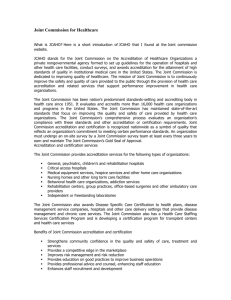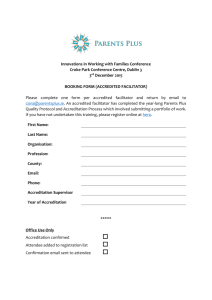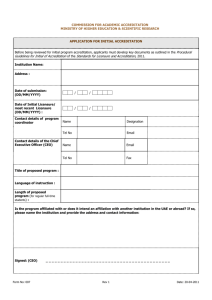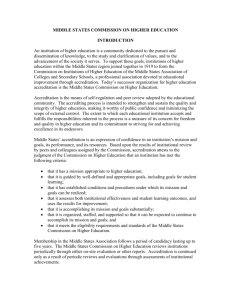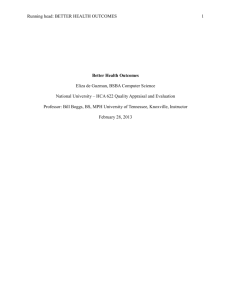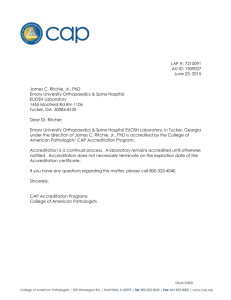In order to perform its functions effectively, a national standards
advertisement
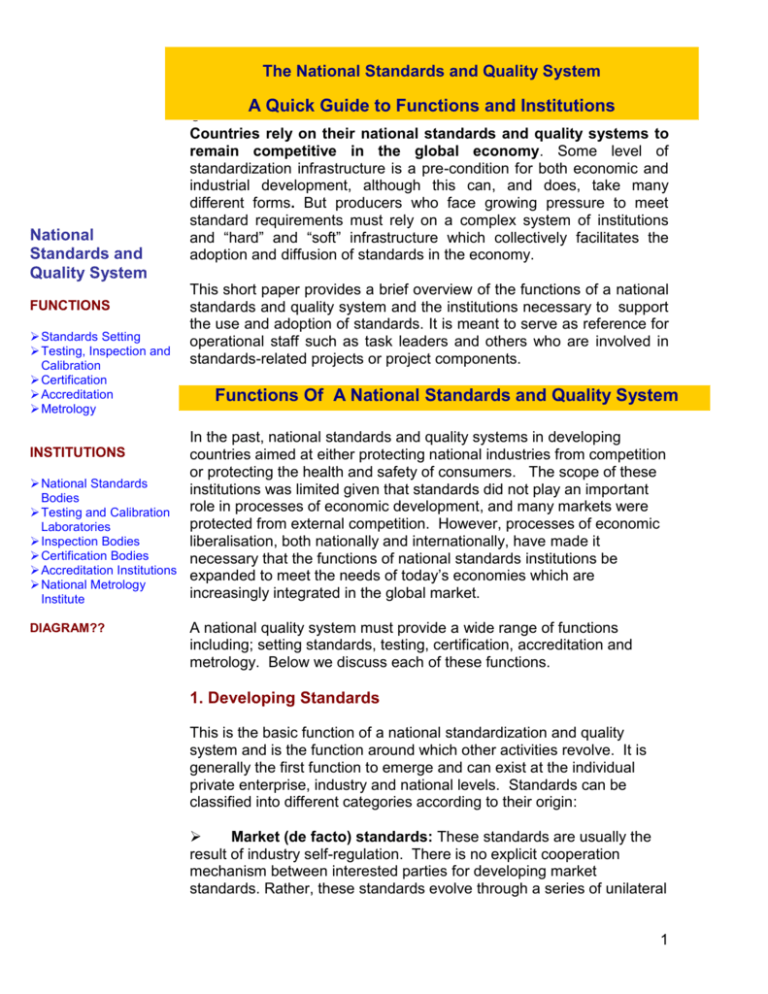
The National Standards and Quality System A Quick Guide to Functions and Institutions National Standards and Quality System FUNCTIONS Standards Setting Testing, Inspection and Calibration Certification Accreditation Metrology C Countries rely on their national standards and quality systems to remain competitive in the global economy. Some level of standardization infrastructure is a pre-condition for both economic and industrial development, although this can, and does, take many different forms. But producers who face growing pressure to meet standard requirements must rely on a complex system of institutions and “hard” and “soft” infrastructure which collectively facilitates the adoption and diffusion of standards in the economy. This short paper provides a brief overview of the functions of a national standards and quality system and the institutions necessary to support the use and adoption of standards. It is meant to serve as reference for operational staff such as task leaders and others who are involved in standards-related projects or project components. Functions Of A National Standards and Quality System In the past, national standards and quality systems in developing countries aimed at either protecting national industries from competition or protecting the health and safety of consumers. The scope of these National Standards institutions was limited given that standards did not play an important Bodies role in processes of economic development, and many markets were Testing and Calibration protected from external competition. However, processes of economic Laboratories Inspection Bodies liberalisation, both nationally and internationally, have made it Certification Bodies necessary that the functions of national standards institutions be Accreditation Institutions expanded to meet the needs of today’s economies which are National Metrology increasingly integrated in the global market. Institute INSTITUTIONS DIAGRAM?? A national quality system must provide a wide range of functions including; setting standards, testing, certification, accreditation and metrology. Below we discuss each of these functions. 1. Developing Standards This is the basic function of a national standardization and quality system and is the function around which other activities revolve. It is generally the first function to emerge and can exist at the individual private enterprise, industry and national levels. Standards can be classified into different categories according to their origin: Market (de facto) standards: These standards are usually the result of industry self-regulation. There is no explicit cooperation mechanism between interested parties for developing market standards. Rather, these standards evolve through a series of unilateral 1 irrevocable purchasing decisions. De facto standards are typically defined after a product has been accepted by a large community of users. Commonly cited examples of de facto standards include the British system of measurements (e.g., inches, feet, pounds, etc.) that is still dominant in the U.S, and the QWERTY keyboard. Formal (de jure) standards involve an explicit coordination and negotiation process prior to commitment to a particular standard. Formal standards could be either voluntary or mandatory. - Voluntary standards which are nationally or internationally accepted procedures or guidelines usually developed through a consensusbased process that involves stakeholders, both producers and consumers, who agree on a standard through an open committee. ISO standards, such as ISO 9000, which provides guidelines for quality management at the firm level, is an example of a voluntary standards. - Mandatory standards or technical regulations are usually developed by governmental authorities and their application is compulsory. This is the case of standards that regulate, for example, the environmental impact of products and processes. 2. Testing, Calibration and Inspection Testing involves determining the characteristics or performance of a product or process according to a specified procedure. Testing is often a requirement for certification, but is also used for a variety of purposes such as product design and research, quality control, satisfying contractual agreements and regulatory requirements and buyer protection and information. Calibration involves the determination of the relationship between an instrument’s input and the magnitude or response of its output. Inspection is also a form of assessment but it relies on less sophisticated instruments than testing. The inspection of products is usually conducted by visual means or using simple instruments Testing, calibration and inspection are integral components of the conformity assessment process. Independent testing laboratories and inspection bodies can be contracted by a firm to obtain a test or inspection certificate as evidence that a product or process conforms to certain characteristics. Independent calibration laboratories can be used to guarantee the performance of a company’s measurement equipment. A third-party laboratory calibration certificate can provide evidence that a firm has the quality control equipment that meets the requirement for product or system certification. In certain cases, testing, calibration and inspection are required 2 for firms to implement a quality control system, such as ISO 9000. These may be essential elements in proving that a firm is complying with customer requirements. 3. Certification Certification provides assurance that a product, service, system, process or material conforms to one or more standards or specifications. Although there exists some self-certification schemes, certification is usually conducted by a third party that is independent from the supplier or purchaser. Product certification can involve various degrees of confidence, depending on the referenced standard. In the simplest case, only a prototype or a product from a preproduction run is tested and inspected against a specific standard. More vigilant tests involve a surveillance of the manufacturing process, random testing of samples, batch-testing and 100% testing, where every product is examined individually. Process certification involves an assessment of the different variables, such as materials and equipment that have an impact on a firm’s output. For example, certification of a firm’s manufacturing process quality to a certain standard may be based on an audit verifying the quality of the components or materials, equipment, equipment calibration and maintenance, the training and experience of the personnel and the environmental conditions In addition to product certification, certification schemes increasingly involve systems. Quality management system certification involves auditing of a firm’s management practices, and, when applicable, collect data and conduct tests, to ensure that they conform to a quality standard. Certification benefits producers, consumers and government regulators, as well as international trade. Manufacturers and service providers can have their products or their management systems certified to a particular standards to distinguish themselves from less reputable suppliers. Buyers benefit from certification because it allows them to compare and differentiate products and services in terms of quality, safety or other desirable characteristics. Certification is more transparent than relying on a producer’s reputation as it conveys standardized information about the capabilities of a producer that may not be obtainable elsewhere. Finally, regulators benefit from certification because it provides them with a system to enforce governmental health, safety and environmental legislation. The costs associated with certification vary in range and magnitude depending on the standard for which a firm is seeking certification. An organization faces both internal and external certification costs. Internal costs include salaries of employees dedicated to meeting the certification requirements, added to documentation costs, overhead costs, internal training expenses and investment in production and quality-control technologies. External costs involve the procurement of services outside the firm. The firm can prepare 3 itself for the certification process by hiring internal auditors or seeking assistance from external consultants to provide diagnostic and training services. 4. Accreditation Accreditation is the procedure by which an authoritative body gives formal recognition that an organization or person is competent to carry out certain task, such as certification. Organizations or bodies seeking certification usually do so on a voluntary basis as a proof of competence in a given area. Accreditation provides certification and inspection bodies, as well as testing and calibration laboratories with a means to signal that they are conducting their work to appropriate standards and that they are able to provide reliable services. The accreditation body evaluates the personnel and supporting management system of the candidates for accreditation and can request practical tests for laboratories when relevant. These tests take the form of proficiency testing schemes, through which the measurement results of different laboratories are compared. Accreditation is usually valid for a few years after initial assessment, during which the accredited organization is subject to regular surveillance. Accreditation contributes to economic development by reducing risk, ensuring quality and increasing productivity. It protects customers from the risk of receiving poor service by guaranteeing that accredited organizations are both independent and technically competent. Accreditation also enhances quality in the economy by enhancing the credibility of the entire conformity assessment system and decreasing information asymmetries. The scope of accreditation can be broad or specific, depending on the accreditation body or the product and standard for which the certification body is seeking accreditation. In some cases, a certification body will receive multiple accreditations to allow it to cover many areas. Likewise, laboratories can be accredited for a broad or narrow range of tests and calibrations. 5. Metrology Metrology is the study of a system of measures. Measurements are not only an integral part of the national quality system, but are an integral part of our daily lives. Accurate measurements allow equipment to be calibrated to produce consistent results, and they allow tests to be performed to verify if a product or process conform to pre-determined requirements. Correct measurements also play a key role in the economy by facilitating commercial transactions and their regulation. Metrology is usually supported by one or more institutions in a given country. They provide a support infrastructure for all measurement-related activities performed by enterprises, individuals and governments. Scientific metrology is the branch of metrology concerned with developing measurement standards and promoting their acceptance and 4 equivalence. Legal metrology consists of the legislative, administrative and technical procedures established to regulate the credibility of measurements related to official controls, trade, health, safety and the environment. 6. Standards Information Information on national, foreign and international standards is of vital importance to manufacturers, users and traders of products and services. National standardization infrastructure plays an important role in disseminating this information in an effective and low cost manner. More generally, it has an important function in promoting standardization activities. INSTITUTIONS At the most basic level, national standards institutions should be able to develop standards that meet current industry and consumer needs and contain technical specifications that enhance quality, safety, interchangeability, compatibility, and information diffusion. Yet, the mere existence of standards is not sufficient to ensure their proper diffusion and the realization of their positive economic effects. For many standards, especially quality and safety standards, the incentives for selfenforcement are low and producers have much to gain by claiming that a noncompliant product or process adheres to a standard. Furthermore, the highly technical content of some standards may make it difficult for producers to know whether they have appropriately complied with a standard. A country requires institutions that develop, evaluate and verify compliance with standards. All activities that are necessary to demonstrate that a product or process conforms to technical specifications such as those included in technical standards are part of what is called the conformity assessment framework. In many developing countries, standards institutions have operated with the objective of protecting national industries with local and tailor-made standards. 5 In order to perform its functions effectively, a national standards institution must conform to certain key operating principles: 1. It must be independent from government influence in terms of its administrative and (in particular) technical functions. 2. It must be responsive to the needs of industry as well as public policy-makers. 3. It must be sufficiently flexible to enable new priorities and demands to be addressed. 4. It must be both politically and financially stable in order that longer-term work plans can be developed and implemented. 5. It should establish and operate to a clearly defined strategic plan that reflects its operational realities and the needs of industry and policy-makers. 6. It should be able to participate in standardization activities at the regional and (preferably) international levels. 1- National Standards Bodies National standards bodies are organizations that bring together public and private stakeholders to develop official national standards. These bodies can be either public-sector entities or non-profit private organizations. Standards bodies usually adopt voluntary or mandatory standards through consensus and publish them to make them available to industry, public sector institutions and consumers. The legal status of standardization bodies varies widely across countries. A 2003 survey of the 147 members of the International Organization for Standardization (ISO) showed that half of standardization bodies were public organizations, while the other half were private organizations (ISO 2003a). The process of standards setting is governed by international laws and charters which a standards setting body is required to follow in order to become accredited as a national standards developer. These principles can be summarized as follows: Written procedures based on the consensus principle1 should govern the methods used to develop standards. These procedures should be available to interested parties. The standards development process should be open. Standards bodies should be pro-active in opening participation to all interested parties and there should be broad-based public reviews of standards 6 drafts. Foreign parties should be given equal access to the public review process. The standardization process should be based on a balanced representation of interests with no dominating single interest. There must be an appeals mechanism for participants who believe that the procedures guiding the standards development process have not been respected. Standards should be reviewed periodically and revised in a timely manner. Some national standards bodies are involved in the development of mandatory standards. But in some cases, the voluntary standards developed by private standardization bodies are referenced in regulation and effectively become law, or technical regulations. In other instances, the national standardization bodies are directly responsible for developing both voluntary and mandatory standards. 2. Testing and Calibration Laboratories Testing and calibration laboratories and inspection bodies can differ widely from one another in size, range of services, legal status, purpose and technical competence. Testing and calibration laboratories and inspection bodies abound in most economies. They can operate as government regulatory laboratories or bodies, government research laboratories, university laboratories, independent private sector laboratories or bodies, manufacturers’ in-house laboratories or customer’s in-house laboratories. Testing laboratories come in all forms and sizes. They are usually private sector entities when they concern the voluntary field, and can be found in both the public and private sectors when they test against mandatory requirements. The certification market usually involves a number of competing private bodies. In the vast majority of countries, subsidiaries of the twenty or so largest global certification bodies have an important share of the market. While most certification bodies operate as private for-profit companies, others operate as individual not-for-profit organizations or as part of industry associations. Commercial calibration laboratories compete for final industrial users or what is called the secondary calibration market. Those users do not themselves offer commercial calibration services. 3. Inspection Bodies Inspection can be conducted alone or in combination with testing to determine whether a product or process meets certain requirements. The inspection of products is usually conducted by visual means or using simple instruments. In contrast to testing, the outcome of the inspection process depends highly on 7 the subjective judgment and experience of the inspector. Like testing laboratories, inspection bodies can be either the private or public sector entities, depending on their role in mandatory requirements. 4. Certfication Bodies Certification bodies are usually commercial for-profit or non-profit entities, and in undeveloped markets they are sometimes public sector organizations. There are internationally-accepted guidelines outlining the proper operation of a certification body.2 In order to produce credible assessments of a product or process, it is generally accepted that a certification body should adhere to the following principles: The certification body should be impartial and independent For example, a certification body should not offer consulting services that are aimed at improving a client’s chances of obtaining certification, and auditing personnel should not be simultaneously employed in such activities. The certification body should be objective. For this purpose, it should have the proper resources to undertake the relevant tests and inspections, and auditors should have proper technical expertise and competence. To demonstrate their competencies, auditing personnel often seek auditor certification by specialized national bodies. Finally, all information collected through the evaluation process should remain confidential. Certification bodies often obtain access to detailed information about the operations and technology of a candidate organization 5. Accreditation Institutions Accreditation bodies have different structures and legal statuses in different countries. Accreditation bodies may be subject to various degrees of government involvement depending on the country. Nonetheless, countries are increasingly finding the government-managed model less desirable than a public autonomous agency or non-profit organization. This is due to a recognized need for greater flexibility and independence. The structure of the national accreditation system may also vary but the norm is to have a single national accreditation body. In a few countries, such as South Korea, laboratory accreditations and certification body accreditations are the responsibilities of two distinct bodies. An extreme case is the United States, where a number of federal, state and local government accreditation bodies operate in parallel with private sector accreditation bodies. What matters more than legal status and structure is the ability of the accreditation body to comply with a few key principles. Internationally-accepted standards, guides and 2 These guidelines are documented in ISO/IEC Guides 62, 65 and 66. 8 codes of conduct emphasize the need for impartiality, objectivity, nondiscriminatory policies and practices, and for the avoidance of conflicts of interests. Involving stakeholders in the governance and technical functions of the accreditation body can help ensure impartiality and build confidence in the organization. Some countries do not have a national accreditation body and have decided to provide accreditation services by engaging in agreements with foreign accreditation bodies or through regional cooperation. This is possible because national accreditation bodies often allow organizations from other countries to seek accreditation. However, to be effective, a foreign accreditation must be recognized in an accredited organization’s home country. One option is to create a nominal national accreditation body to contract a foreign body to undertake accreditation activity on its behalf while retaining some authority over the process. Alternately, regional accreditation bodies have been established to spread costs among several countries. The Joint Accreditation System of Australia and New Zealand is an example of such a model. The Southern African Development Community (SADC) is also building a novel regional model for accreditation. It is important to note that although regional bodies may provide superior solutions in some cases, they may be very difficult to implement for political reasons. Conflicts of interests can arise when accreditation bodies are involved in other activities. Offering certification, testing and calibration services are a source of conflict of interest because it puts the accreditation body in competition with potential candidates for accreditation. Not all related commercial activities present these problems, and an experienced accreditation body may be in a unique position to offer some services to industry. This notably includes training services, not only for future assessors, but also for technical laboratory staff who conduct internal audits and quality management staff in firms. The objectivity of the accreditation process largely depends on the quality of its technical staff. Assessor training programs are highly specialized and are usually only found in mature accreditation bodies. The staff of new and developing country accreditation bodies often receive training through formal courses and field practice in more experienced bodies abroad. Assessment teams must have sufficient collective scientific and technical skills to understand the testing and calibration activities of laboratories and the management systems of certification bodies. In the area of laboratory accreditation, technical expertise requires assessors to have current knowledge of the latest technologies and scientific practices. In certain fields, it may be difficult for full-time assessors to maintain an appropriate level of current knowledge to perform their tasks reliably. For this reason, assessors 9 are often selected from accredited organizations, academic or technical institutions and are engaged on short-term contracts or as volunteers. For assistance with accreditation, lead assessors can also rely on external technical experts, although these experts may have no formal training in conformity assessment. Establishing an accreditation body requires significant investments and government support. Accreditation requires well-trained personnel and may have important technological requirements, even for simple systems. The accreditation process is costly and time-consuming, as it must be accompanied by surveillance activities. It also involves a lengthy learning process that can only be realized by having a large customer base. With the exception of countries where there are large markets, such as the United States, accreditation is not usually financially self-sufficient and depends on government subsidies (UNIDO 2003). Investing in accreditation needs to be justified by an adequate demand for accreditation from certification bodies and testing and calibration laboratories, or at least a demand for conformity assessment services from domestic firms and organizations. In most countries, accreditation bodies indirectly benefit from government support through policies that provide incentives for accreditation or that require product certification from accredited entities in public procurement provision. 6. The National Metrology Institute The role of a National Metrology Institute (NMI) is to establish the national measurement system, to maintain, develop and diffuse measurement standards for basic units and to diffuse metrological expertise to the economy. Countries often have a single NMI, but when there are several NMIs each is responsible for distinct measurement areas. It is more common for NMIs to be public sector organizations, but they can also be private sector organizations. NMIs operate in the primary calibration market: they disseminate measurement standards by providing calibration services to independent calibration laboratories and to other organizations responsible for regulations and standards. Most NMIs in industrialized and rapidly developing countries receive significant funding from their central governments. This is even the case when the NMI is managed by a private organization. Public funding is usually justified by the wide range of individuals and organizations that benefit from the existence of measurement standards. The private sector alone would tend to provide fewer resources to the production and maintenance of measurement standards than is desirable from the point of view of the economy as a whole because of the ‘public good’ nature of these standards. In industrialized countries, governments spend between 0.002% and 0.007% of their GDP on metrology infrastructure. This figure approximates 300 million dollars for the United States. Governments of some rapid-growth East Asian 10 economies have invested as much as 0.01% of their GDP on establishing a measurement infrastructure (BIPM 2003, Quinn 2005). NMIs also fund part of their activities through the fees they charge for their calibration, consulting and R&D services. In most developed countries these fees are determined by the NMIs themselves, while in others they are sometimes determined in the national legislation. Sources This guide was compiled using excerpts and information from: -“Quality and Standards Matter: Implementing Effective Quality Systems to Support Trade and Competitiveness Initiatives.” World Bank September 2006. -“National Laws, Regulations and Institutional Capabilities for Standards Development”. Presentation by Spencer Henson for World Bank. Marc 2003 - WTO guide and code of good practice for certification bodies 11


